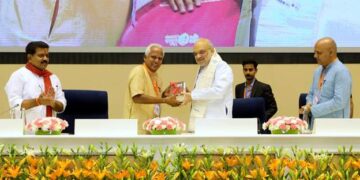By: Dr.ShibenKrishen Raina
Our country just celebrated its 78th Independence Day on August 15, 2024. The national flag, the Tricolor, was hoisted in every home and place, and numerous events, speeches, and addresses took place. But do you know when and where our national flag (Tricolor) was first hoisted in India? Most of us probably don’t know about this. As a matter of fact, the Tricolor was first hoisted on Indian soil in Port Blair, the capital of Andaman and Nicobar, and this Tricolor was hoisted by the famous freedom fighter NetajiSubhas Chandra Bose, a true son of Mother India.
The circumstances surrounding this flag-raising were extraordinary. During World War II, the Andaman and Nicobar Islands had fallen under Japanese occupation in 1942. On December 29, 1943, Netaji arrived in Port Blair for a three-day visit. The following day, he raised the Indian National Flag and declared the island group free from British rule. This declaration was significant because the Japanese had just handed over the nominal authority of the islands to Bose’s Azad Hind Government (Indian National Army). Although the islands remained under de facto Japanese control until 1945, this symbolic act was a powerful gesture-cum-boost for the struggle of the Indian independence movement.
Today, at Flag Point in Port Blair, a 150-foot high flagpole stands as a testament to this historic moment. The Tricolor flying here is not just a national symbol but a reminder of the complex and often overlooked history of India’s freedom struggle.
Visiting Port Blair and seeing this flag on August 15, 2024 arouses a feeling mixed with pride and joy upon. Port Blair’s role in India’s independence movement is, indeed, indelible and deserves wider recognition.
As we reflect on India’s journey to freedom, it’s crucial to remember that the struggle was not confined to the mainland. The story of the first Indian flag in Port Blair highlights the nationwide and even global nature of India’s fight for independence. It also underscores the strategic importance of the Andaman and Nicobar Islands during World War II and in India’s push for self-governance.
As India marches forward, achieving milestones across various sectors, the national flag flying proudly over Port Blair stands as a poignant reminder of the nation’s hard-won independence. This tricolor, unfurling in the Andaman and Nicobar Islands, serves a dual purpose: it’s not merely a symbol of national pride, but also a testament to the far-reaching and diverse nature of India’s struggle for freedom.
The flag’s presence in this remote corner of our country underscores the vast geographical expanse of India’s fight against colonial rule. It honors the countless freedom fighters from every corner of the subcontinent who contributed to the nation’s liberation. Moreover, it celebrates the unity in diversity that has become a hallmark of modern India, reminding citizens and visitors alike of the country’s rich cultural heritage and shared history.
As India continues to progress on the global stage, this flag at Port Blair stands tall, linking the nation’s past struggles with its present achievements and future aspirations. The next time we see the Indian Tricolor flying high, we must remember its first unfurling in Port Blair. Raising of Tricolor at Port Blair is a story of courage, strategic thinking, and the relentless pursuit of freedom that characterized India’s independence movement. Port Blair’s place in this narrative ensures that the Andaman and Nicobar Islands will forever hold a special place in the annals of Indian history and its independence movement.
During my visit to Port Blair on August 15, 2024, seeing this Tricolor filled my heart with pride-mixed joy. Port Blair can never be forgotten in the history of our country’s freedom struggle.
Former Fellow, IIAS, Shimla. skraina123@gmail.com




